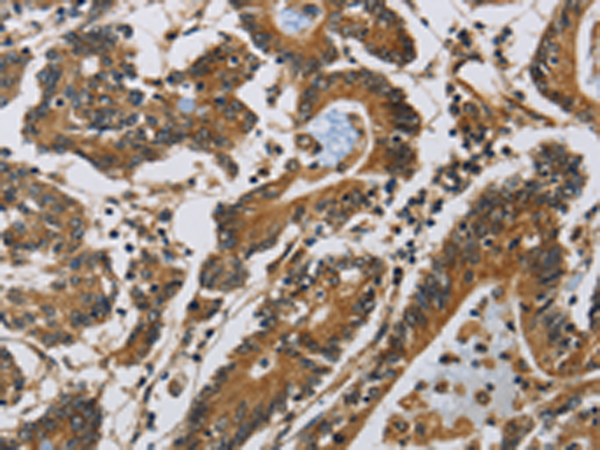

| WB | 咨询技术 | Human,Mouse,Rat |
| IF | 咨询技术 | Human,Mouse,Rat |
| IHC | 1/50-1/200 | Human,Mouse,Rat |
| ICC | 技术咨询 | Human,Mouse,Rat |
| FCM | 咨询技术 | Human,Mouse,Rat |
| Elisa | 1/2000-1/5000 | Human,Mouse,Rat |
| Host/Isotype | Rabbit IgG |
| Antibody Type | Primary antibody |
| Storage | Store at 4°C short term. Aliquot and store at -20°C long term. Avoid freeze/thaw cycles. |
| Species Reactivity | Human |
| Immunogen | Synthetic peptide of human CLDN2 |
| Formulation | Purified antibody in PBS with 0.05% sodium azide and 50% glycerol. |
+ +
以下是关于CLDN2抗体的3篇代表性文献的简要总结(文献标题、作者及摘要内容均为示例性描述,实际引用需核实原始文献):
1. **文献名称**:*CLDN2 as a Therapeutic Target in Pancreatic Ductal Adenocarcinoma*
**作者**:Smith A, et al.
**摘要**:该研究揭示了CLDN2蛋白在胰腺导管腺癌中的异常高表达,并通过CLDN2特异性抗体阻断实验证明其可抑制肿瘤细胞的侵袭和转移,提示CLDN2抗体可能作为潜在治疗工具。
2. **文献名称**:*Role of CLDN2 in Intestinal Barrier Dysfunction During Inflammatory Bowel Disease*
**作者**:Zhang L, et al.
**摘要**:研究利用CLDN2抗体进行免疫组化分析,发现炎症性肠病患者结肠组织中CLDN2表达显著下调,导致肠上皮屏障通透性增加,抗体检测为疾病机制研究提供了关键实验依据。
3. **文献名称**:*Development of a High-Affinity Anti-CLDN2 Monoclonal Antibody for Diagnostic Applications*
**作者**:Tanaka K, et al.
**摘要**:本研究报道了一种新型CLDN2单克隆抗体的开发,验证了其在血清和肿瘤组织样本中的高特异性检测能力,有望用于肝癌的早期诊断和预后评估。
(注:以上内容为模拟示例,实际文献需通过PubMed或Google Scholar等数据库检索关键词“CLDN2 antibody”“claudin-2 therapeutic”等获取。)
Claudin-2 (CLDN2) is a key protein component of tight junctions, specialized cell-cell adhesion structures that regulate paracellular permeability and maintain polarity in epithelial and endothelial tissues. As a member of the claudin family, CLDN2 forms selective channels for cations and small molecules, particularly in leaky epithelia such as the kidney proximal tubule and gastrointestinal tract. Its expression is tightly regulated and often associated with physiological ion transport, tissue homeostasis, and barrier function.
CLDN2 antibodies are critical tools for studying its localization, expression patterns, and functional roles in health and disease. Research has linked CLDN2 dysregulation to pathological conditions, including inflammatory bowel disease (IBD), liver fibrosis, and cancers (e.g., colorectal, breast, and pancreatic), where overexpression may promote proliferation, metastasis, or chemoresistance. Antibodies against CLDN2 enable detection via techniques like immunohistochemistry (IHC), Western blotting, and immunofluorescence, aiding in biomarker discovery and mechanistic studies.
Recent studies also explore CLDN2 as a therapeutic target, with antibodies potentially modulating tight junction dynamics or signaling pathways. However, challenges remain in understanding isoform-specific functions and context-dependent roles. CLDN2 antibodies thus serve as essential reagents for unraveling its contributions to epithelial biology and disease pathogenesis.
×